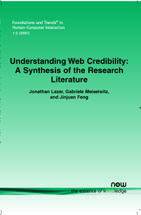Understanding Web Credibility: A Synthesis of the Research Literature
By Jonathan Lazar, Department of Computer and Information Sciences, Universal Usability Laboratory, Towson University, USA, jlazar@towson.edu | Gabriele Meiselwitz, Department of Computer and Information Sciences, Universal Usability Laboratory, Towson University, USA, gmeiselwitz@towson.edu | Jinjuan Feng, Department of Computer and Information Sciences, Universal Usability Laboratory, Towson University, USA, jfeng@towson.edu
Abstract
As more of our communication, commerce, and personal data goes online, credibility becomes an increasingly important issue. How do we determine if our e-commerce sites, our healthcare sites, or our online communication partners are credible? This paper examines the research literature in the area of web credibility. This review starts by examining the cognitive foundations of credibility. Other sections of the paper examine not only the general credibility of web sites, but also online communication, such as e-mail, instant messaging, and online communities. Training and education, as well as future issues (such as CAPTCHAs and phishing), will be addressed. The implications for multiple populations (users, web developers, browser designers, and librarians) will be discussed.
Understanding Web Credibility
As more of our communication, commerce, and personal data goes online, credibility becomes an increasingly important issue. How do we determine if our e-commerce sites, our healthcare sites, or our online communication partners are credible? Understanding Web Credibility: A Synthesis of the Research Literature focuses on the issues related to web credibility. It starts by examining the cognitive foundations of credibility. Other sections examine not only the general credibility of web sites, but also online communication, such as e-mail, IM, and online communities. Training and education, as well as future issues (such as CAPTCHAs and phishing), are also addressed. Finally, the implications for multiple populations (users, web developers, browser designers, and librarians) are discussed, along with some of the future threats to credibility. Understanding Web Credibility: A Synthesis of the Research Literature provides a thorough reading for individuals interested in the topic of credibility.
